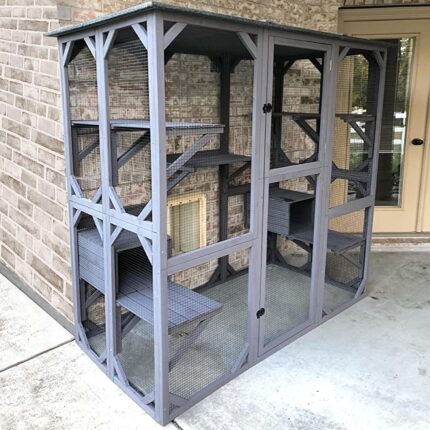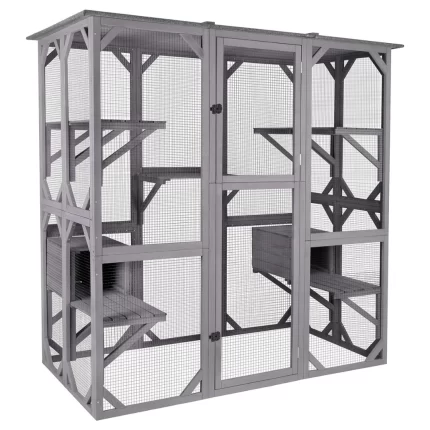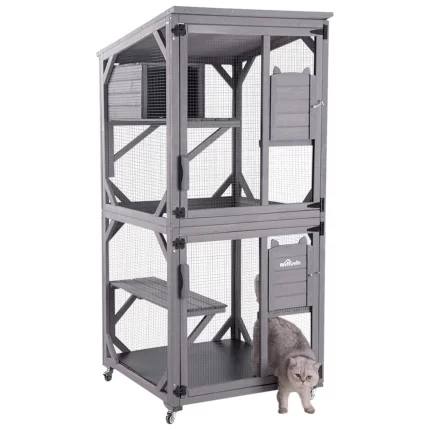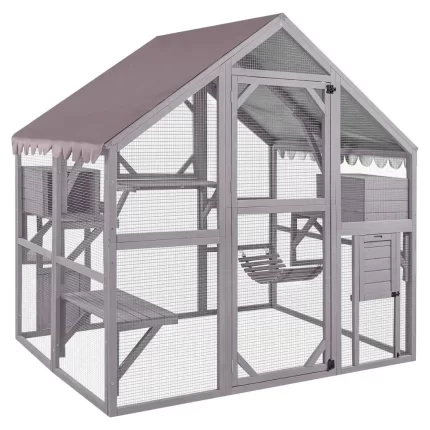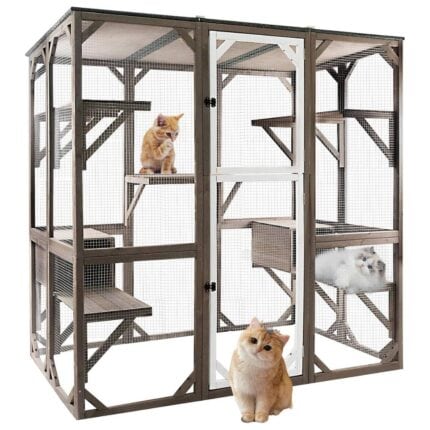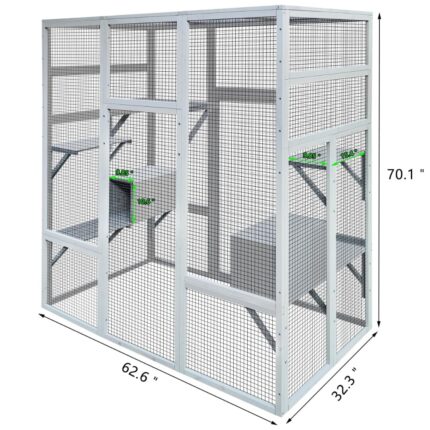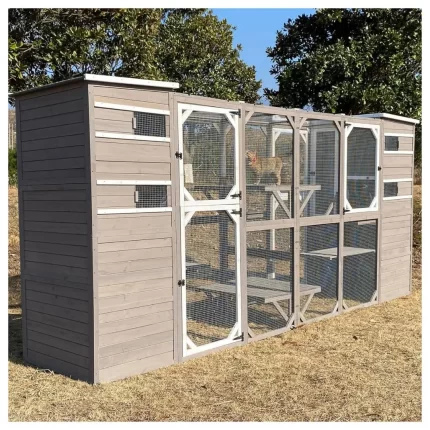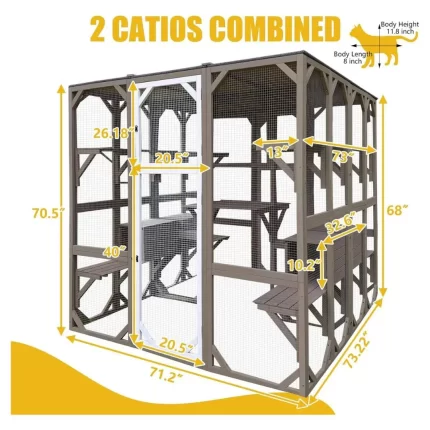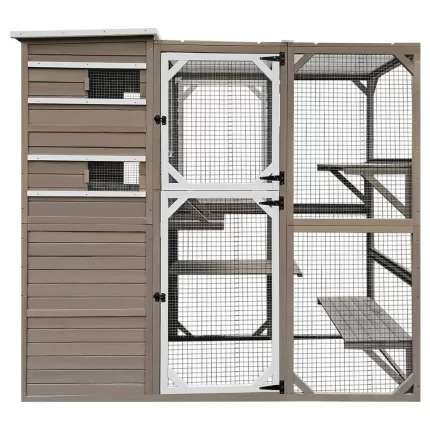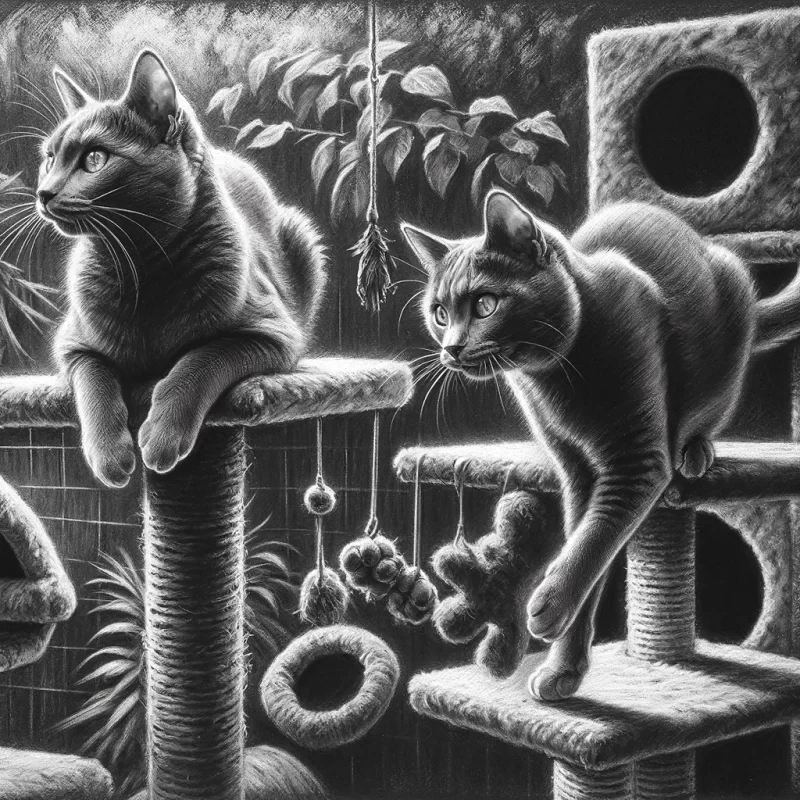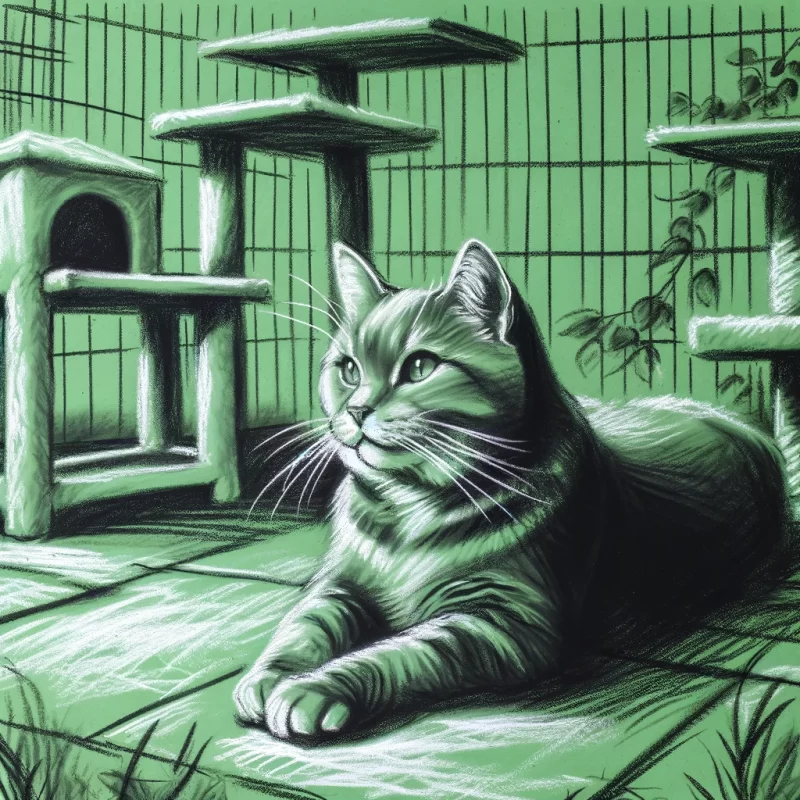Blog
Cat Window Box Overview: Quick Insights
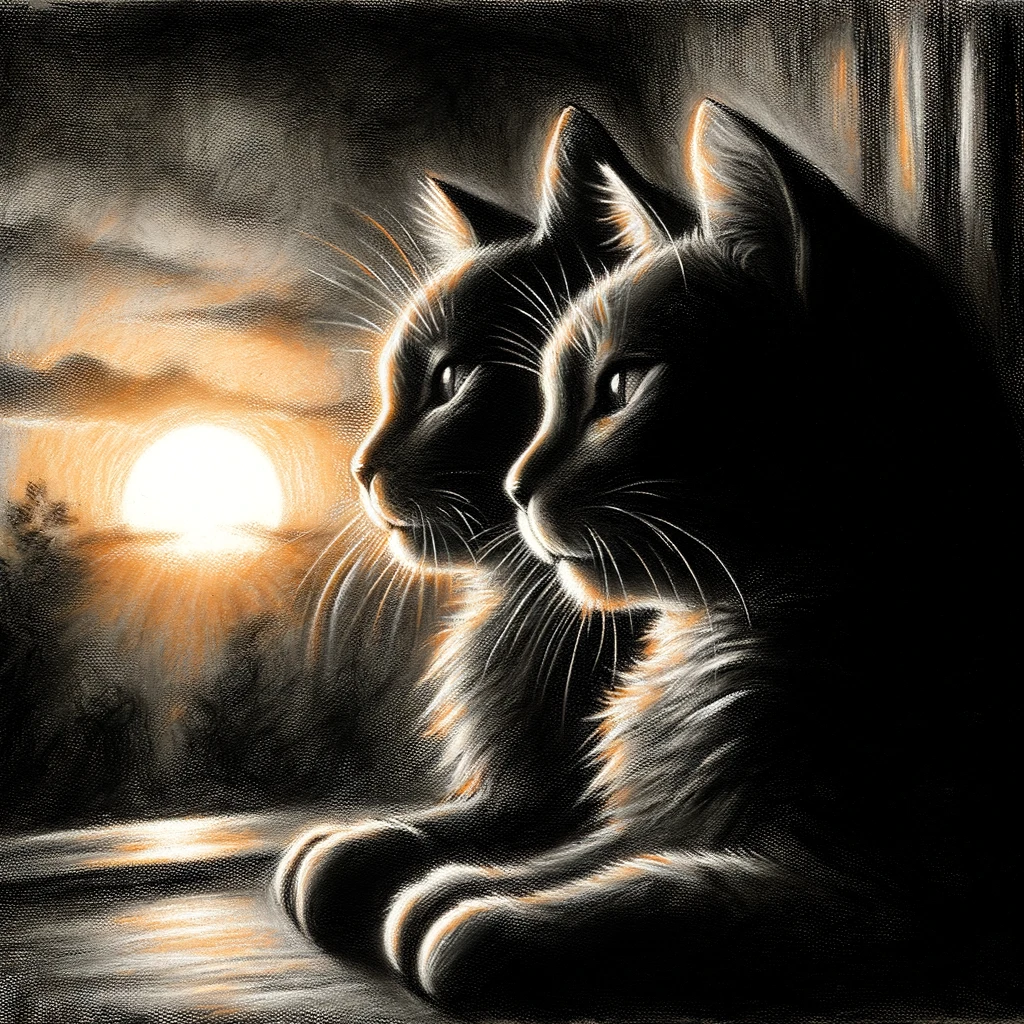
Designing a cat window box melds safety with aesthetics. Find out how to create a cosy sanctuary for your feline friend in this easy-to-follow guide.
Like a lovingly tended garden offering respite to weary travellers, a cat window box provides a personal oasis for your indoor cat, marrying comfort with the allure of the outside world.
Window perches for cats offer a perfect balance of safety and enrichment. By creating a well-designed cat window box, you can not only enhance the aesthetic appeal of your home but also provide a sustainable environment that meets the instinctual needs of your beloved pet.
What is a Cat Window Box?
A cat window box is a specially designed enclosure attached to a window, allowing your indoor cat to have a safe and secure outdoor experience. It is a small space that extends from the inside of your home to the outside, providing a comfortable perch for your feline friend to observe the outside world.
This innovative solution is ideal for cat owners who want to provide their pets with a taste of the great outdoors while still keeping them safe and protected. A cat window box offers a unique opportunity for cats to experience fresh air, sunlight, and the sights and sounds of nature, all from the comfort of their own home.
Cat window boxes come in various shapes and sizes but are typically made of durable materials such as wood or metal. They are designed to withstand weather conditions and provide a stable platform for your cat to rest, play, and enjoy the view.
These window perches often feature a mesh or wire enclosure that ensures your cat cannot escape while still allowing them to feel the breeze and take in the scents of the outdoors. Some cat window boxes include additional features, such as shelves or ramps, to create a more engaging and stimulating environment for your furry friend.
Creating a cat window box requires careful planning and consideration. Factors like the size of your window, the location of the box, and the materials used are crucial to ensure the safety and functionality of the enclosure. It is essential to follow a step-by-step guide to guarantee a successful and enjoyable experience for you and your cat.
In the following sections, we will explore the step-by-step process of setting up a cat window box, covering everything from selecting suitable materials to securing the enclosure to your window.
Comparing Cat Window Boxes to Catios
Regarding providing a safe and engaging outdoor experience for your indoor cat, two popular options are cat window boxes and catios. Both structures offer a way for your cat to enjoy the outdoors while remaining protected from potential dangers. This chapter will compare cat window boxes with catios, helping you decide which option is best for you and your feline companion.
Cat Window Boxes
Cat window boxes are specifically designed cat enclosures attached to a window, allowing your cat to observe the outside world comfortably. These boxes are typically made of durable materials such as wood or metal, ensuring they can withstand various weather conditions. With a mesh or wire enclosure, cat window boxes provide a safe environment for your cat without compromising their view or connection with nature. They are also known for their space-saving nature, making them ideal for apartments or homes with limited outdoor space. Setting up a cat window box requires careful planning, considering factors like the size of your window, the location of the box, and the materials used.
Catios
On the other hand, catios are larger, freestanding structures that offer your cat a more expansive outdoor experience. These enclosed spaces can range from simple to elaborate, with various levels, ramps, and climbing structures to entertain your cat. Catios can be attached to your home or placed in your backyard, allowing your cat to roam safely while enjoying fresh air and exploring their surroundings. These structures are typically built with durable materials like metal or strong mesh, providing a secure and long-lasting outdoor space for your cat. Catios require more space and planning, as they must be properly designed and constructed to provide adequate protection and stimulation for your cat.
Key Differences
While both cat window boxes and catios allow your cat to experience the outdoors, there are a few key differences to consider.
- Size and space: Cat window boxes are generally smaller and attach directly to your window, while catios offer a larger, freestanding area for your cat to roam.
- Complexity: Catios tend to be more complex in their design and construction, with multiple levels and features, whereas cat window boxes are more straightforward in structure.
- Installation: Cat window boxes can be quickly installed by attaching them to your window, whereas catios may require professional installation or extensive DIY work.
- Accessibility: Cat window boxes are always conveniently located indoors, allowing your cat to access them quickly, whenever desired. At the same time, cats may require your cat to go outside to access them.
Ultimately, choosing between a cat window box and a catio depends on factors such as space availability, desired level of complexity, and your cat’s individual needs and preferences. Both options provide your cat with a safe and enjoyable outdoor experience, allowing them to connect with nature while remaining protected.
Essential Window Box Features
When conceptualising a cat window box, prioritise including robust safety measures, such as secure anchors and durable materials resistant to weather and your cat’s exuberant activities.
It should have a comfortable resting place, often lined with soft, washable fabrics to ensure a cosy vantage point.
Adequate shelter from the elements, be it sun or wind, is vital and can be provided by a partial roof or adjustable shades.
Incorporate dynamic elements such as branches or toys for climbing and play to stimulate your cat’s primal instincts.
Proximity to nature can be enhanced through bird feeders or planters affixed nearby, crafting an engaging sensory experience.
Remember, seamlessly integrating your home’s facade maintains aesthetic harmony while providing your feline with the unmatched pleasure of outdoor observation.
Window perches for cats offer a perfect balance of safety and enrichment. By creating a well-designed cat window box, you can not only enhance the aesthetic appeal of your home but also provide a sustainable environment that meets the instinctual needs of your beloved pet.
Safety First: Secure Anchors
Sturdy anchorage is a non-negotiable requirement for any cat window box, ensuring absolute security for your beloved feline.
Enhanced safety measures reduce the risk of injury, offering peace of mind for you and secure lounging for your cherished companion.
For adequate security, anchoring systems must withstand significant forces, accounting for the cat’s weight and dynamic movement, such as leaping and pouncing.
It is imperative to use weather-resistant materials for anchors to ensure longevity and reliability, creating a haven that stands the test of time for your feline friend.
Comfort Matters: Cushioning and Space
The essence of a comfortable window box lies in its cushioning, a pivotal element that supports your cat’s inclination for long, indulgent lounging episodes. Adequately thick, removable cushions facilitate ease of cleaning and adaptability to seasonal changes.
Space is incredibly significant within the cat window box to facilitate unencumbered movement and stretching. Emphasise a design that prioritises spaciousness without compromising structural integrity.
Furthermore, the cushion placement should correspond with visual access to the outdoors, ensuring that the cat can relish panoramic views (incorporating bird’s-eye perspectives of their surroundings) in complete comfort.
Cushions should also be of a material that retains its shape over time, resisting compression from repeated use, to provide a sustained quality of comfort. Additionally, non-skid bases prevent shifting, ensuring the cushion remains in place during energetic play or abrupt movements.
It is critical to consider the specific needs of ageing felines by selecting orthopaedic cushions, which deliver vital support for joints and alleviate pressure points for a restful experience. These assist in maintaining your cat’s health and comfort levels throughout different stages of their life.
Lastly, the area of the window box should imbue a sense of tranquillity and security. Careful attention to cushion comfort and ample space can alleviate stress and enhance the well-being of your feline companion.
Weatherproofing Your Cat’s View
Ensuring your cat’s window box is properly weatherproofed is pivotal for their comfort and safety.
- Insulate the window box with appropriate materials to maintain a stable temperature.
- Choose durable, water-resistant materials for the outer construction.
- Provide a sloped roof design to shed rainfall effectively.
- Integrate a transparent, UV-resistant material such as polycarbonate for the viewing pane.
- Equip the window box with a removable weatherproof cover during extreme conditions.
The judicious application of these weatherproofing strategies will not only extend the lifespan of the window box. Still, it will ensure your cat can enjoy their observational perch regardless of weather conditions.
DIY Cat Window Box Plans
When conceptualising DIY cat window box plans, prioritise safety and structural stability. Begin drafting a scaled blueprint that accurately reflects your window’s dimensions, allowing ample movement within the cat’s new vantage point.
Materials selection should include rot-resistant wood such as cedar or pressure-treated lumber, ensuring a durable foundation. Moreover, incorporate fine mesh or wire to provide ventilation while preventing your cat from escaping. Using non-toxic paints and stains is also essential to safeguard your cat’s health.
Adhere to a meticulous assembly process, ensuring all fixtures are secure enough to withstand your cat’s activity. Integrating comfortable, washable cushions will afford your cat a cosy observation spot.
Using Repurposed Materials
Repurposing materials for a cat window box can be an eco-friendly and creative endeavour. Upcycling existing resources minimises waste and lends a unique touch to your pet’s haven.
- Wooden crates or pallets: Sturdy and readily available, they can be transformed into a rustic window box frame.
- Old cabinets or drawers: With minor modifications, these can serve as the base for a cat perch.
- Salvaged wire mesh: Essential for safety, repurposed mesh can enclose the window box securely.
- Reclaimed hardware: Hinges, screws, and brackets from previous projects can be reused to assemble and affix the window box.
Sourcing materials from what you already have can significantly reduce the carbon footprint of new product manufacturing.
Each repurposed item should be thoroughly inspected to ensure it’s free of contaminants and splinters that could harm your feline friend. Double check!
Step-by-Step Construction Guide
Begin with a detailed plan that includes measurements of your window and the desired dimensions of the cat window box, ensuring an accurate fit and optimal functionality.
Identify and gather all necessary tools and repurposed materials listed before construction begins.
With safety as a priority, sand down any reclaimed wood or metal edges to remove potential splinters or sharp areas. Secure all sides with durable hardware to guarantee a stable structure. Ensure the entryway is accessible and comfortable for your cat, with no protruding elements.
Finally, install a weatherproof cushion or bedding inside the window box, providing a comfortable space for your cat. Affix the structure securely to the window using reliable mounting techniques to prevent accidents. Regularly inspect the window box for any wear or damage, especially the fixtures and structural integrity, to maintain your cat’s safe and enjoyable environment.
Pre-Made Window Box Solutions
For individuals seeking a convenient solution, the market offers a variety of pre-constructed cat window boxes. These units come in multiple styles and sizes, fitting a broad spectrum of window dimensions and aesthetic preferences. Most pre-made options incorporate durable materials and secure fixings, ensuring a safe and lasting addition to your home.
Pre-made window boxes often feature advanced elements such as UV-resistant construction and climate-adaptive materials. Such considerations are vital for sustaining the structure’s integrity over time and providing a comfortable, weather-protected haven for your feline companion.
Evaluating Top Retail Options
Browse selections with user ratings in mind.
Numerous factors contribute to selecting an apt cat window box. One must comprehensively analyse consumer reviews and safety records, illuminating each product’s reliability and overall satisfaction. Additionally, focusing on brands with a track record of quality assurance lends credibility to the potential purchase.
Warranty policies are particularly revealing.
Consider the extent of customisation available.
The breadth of customisation options should not be overlooked – from adjustable dimensions to personalised features such as added scratch pads or perches. These factors enhance the compatibility of the window box with both the owner’s preferences and the feline’s comfort.
Align with the latest trends in sustainability.
It’s critical to evaluate the sustainability of each option, focusing on products that prioritise environmentally friendly materials and production practices. Amid the increasing emphasis on ecological responsibility, leading brands in the 2024 market are expected to offer window boxes that complement sustainable living standards. These options serve the pet’s needs and align with the conservation efforts of responsible cat ownership.
Customisation for Your Cat
Customisation transcends mere aesthetics; it defines the functionality and comfort of your cat’s window box. Reflect on specific design elements that align with your cat’s behaviour and preferences to ensure optimal satisfaction and use.
Your feline’s distinct personality necessitates a personalised approach when selecting accessories and modifications. Consider elements such as scratch-resistant surfaces, soft bedding materials, and interactive toys that can be integrated into the design, enhancing your cat’s environmental enrichment.
Moreover, the structural integrity of the window box must be tailored to accommodate your cat’s weight and activity level. A heavier or more active cat requires a robust construction with secure fittings to prevent untoward incidents, ensuring longevity and safety.
To truly cater to individual preferences, explore options that allow for seasonal adaptations. Removable covers for colder weather or breathable mesh for ventilation during warmer months contribute significantly to your pet’s year-round comfort and well-being.
Incorporating these tailored features underscores your commitment to your cat’s happiness and demonstrates an elevated standard of responsible pet ownership. Your attention to detail will reflect in a window box that resonates with you and your beloved pet.
Creative Themes and Extras
For the aesthetically inclined, a coastal or rainforest motif can immerse your feline in a nature-inspired sanctuary.
Given the visual acuity of cats, employing a colour scheme that stimulates their senses, such as greens and blues, may enhance their engagement and contentment.
Accessories like bird feeders or appealing plant arrangements near the window box can enrich your cat’s visual and hunting simulations.
Incorporating Playful Elements
Cats naturally exhibit a penchant for play.
In designing window boxes, it’s essential to integrate elements that will engage and captivate your cat’s curiosity. Various toys, such as dangling feather teasers or interactive spring-loaded mice, can offer an outlet for playful behaviour and mental stimulation, which is especially advantageous for indoor felines. Furthermore, adding shelves or steps can invite acrobatic displays and optimise the utility of the vertical space within your cat’s window retreat.
Incorporate textures to entice tactile exploration.
Perches and bridges should be sturdy and secure, a testament to your commitment to safety and durability. It’s advisable to select resilient materials that can withstand claws and weight. Such attentiveness to construction ensures a durable play area that remains safe for your cat.
The finishing touches should reflect contemporary cat behavioural understandings.
With innovation at the forefront, some recent enhancements include interactive panels or puzzle feeders that dispense treats. This encourages cognitive engagement and a healthy level of physical exertion, aligning with the latest insights into feline enrichment and well-being delineated by experts in the field. These dynamic additions offer a multilayered experience within the confines of the window box sanctuary.
Nature-Inspired Designs
Embracing the essence of the outdoors, nature-inspired designs for cat window boxes evoke the wilderness from which domestic cats ancestrally hail. Incorporating elements such as driftwood perches, live plants, and textured grass-like mats can simulate an outdoor environment within the safe confines of an indoor space.
Realistic features promote instinctual behaviours in felines. Simulating a cat’s natural habitat encourages organic interaction with their surroundings, leading to a more content and well-adjusted pet.
Commonly, materials that mimic the textures of the outdoors, such as sisal, jute, or unprocessed wool, are integrated into these window box designs to provide sensory stimulation.
Durable faux turf or a selection of non-toxic plants can bring a touch of verdancy to your feline’s vantage point, fostering an environment that nourishes the instinct to explore and forage.
A water feature might seem unconventional, yet a minor, recirculating stream can enchant cats, captivate their senses with movement and sound, and cultivate a meditative atmosphere reminiscent of a serene forest setting.
Ultimately, nature-inspired designs aim not mere aesthetics; responsible selections of materials and flora create a harmonious habitat that prioritises your cat’s physical and psychological well-being.
Final Thoughts: Creating a Perfect Haven for Your Feline Friend
Designing and setting up a cat window box is a rewarding endeavour that allows you to provide a safe and enriching outdoor experience for your indoor cat. By following the step-by-step guide and considering the essential features, you can create a perfect haven that meets your cat’s instinctual needs and enhances the aesthetic appeal of your home.
Safety should always be a priority when building a cat window box. Ensure you use secure anchors and durable materials to withstand the forces exerted by your cat’s movement. Comfort is another crucial aspect, with comfortable resting places and ample space for your cat to move and stretch. Weatherproofing the window box will protect your cat from the elements, and incorporating dynamic elements and proximities to nature will provide an engaging sensory experience.
Whether you build a DIY cat window box or opt for a pre-made solution, customisation is key. Tailoring the window box to your cat’s specific needs and preferences and incorporating playful elements and nature-inspired designs will create a truly personalised and stimulating environment for your feline friend.
Remember, a cat window box is not just a space for your cat to observe the outside world but a sanctuary where they can feel connected to nature while remaining safe and protected. The attention to detail and careful planning in creating this space will benefit your cat and enhance your bond and the overall well-being of your beloved pet.
So go ahead, embark on this exciting journey of creating a cat window box, and watch as your cat enjoys the pleasures of the outdoors from the comfort of their home.
FAQ
Here are some commonly asked questions about cat window boxes and their setup:
What materials are widely used for cat window boxes?
Cat window boxes are commonly constructed using various materials, each offering unique benefits. Two popular choices for cat window box construction are wood and metal.
Wooden cat window boxes are favoured for their natural look and ability to blend seamlessly with the surrounding decor. They are typically made from sturdy and weather-resistant types of wood, such as cedar or pine. These materials provide durability and ensure the window box can withstand various weather conditions, including rain and sunlight exposure.
On the other hand, metal cat window boxes are known for their strength and longevity. They are often made from materials like stainless steel or aluminium, which offer excellent resistance to rust and corrosion. Metal window boxes are particularly suitable for areas with harsh weather conditions or cat owners looking for a more modern and sleek design.
Regardless of the material chosen, ensuring that the cat window box is securely installed and can support your cat’s weight is essential. Regular maintenance and inspections are also recommended to ensure the longevity and safety of the window box.
By selecting the right material for your cat window box, you can create a safe and comfortable space for your feline friend to enjoy the view while adding a touch of style to your home.
How do cat window boxes differ from catios?
Cat window boxes and catios are designed to provide cats access to the outdoors while ensuring their safety. However, there are some critical differences between the two.
Cat window boxes, as the name suggests, are attached to windows and offer a compact and convenient space for cats to enjoy the view and fresh air. They are typically smaller and simpler in structure, consisting of a platform or perch securely attached to the window frame. Cat window boxes are ideal for apartments or homes with limited outdoor space, as they allow cats to experience the outdoors without needing a dedicated outdoor enclosure.
On the other hand, catios, short for “cat patios,” are larger freestanding structures that provide a more expansive outdoor experience for cats. Catios are typically built as enclosed outdoor enclosures or screened-in porches that allow cats to roam, climb, and explore in a safe and controlled environment. They offer more space for cats to exercise, play, and engage in natural behaviours like climbing and scratching. Catios are an excellent option for owners with larger outdoor areas or who want to provide their cats with a more enriched outdoor experience.
While cat window boxes are designed to be attached to windows, catios can be standalone structures built in the yard or attached to the house. They often include ramps, shelves, scratching posts, and hiding spots to provide a stimulating and engaging cat environment.
Choosing between a cat window box and a catio depends on available space, budget, and your cat’s specific needs and preferences. Both options offer a safe and enjoyable way for cats to experience the outdoors while protecting them from potential dangers.
What are some essential features of a cat window box?
When designing a cat window box, there are several essential features to consider to ensure the comfort and safety of your feline friend:
- Safety Measures: Prioritizing safety when constructing a cat window box is crucial. Use secure anchors and sturdy materials to attach the window box to the frame firmly. This will prevent accidents or falls and provide a stable platform for your cat.
- Durable Materials: Choose durable and weather-resistant materials to withstand outdoor conditions. Standard options include wood or metal. These materials should withstand exposure to sunlight, rain, and other elements without deteriorating.
- Comfortable Resting Place: Provide a comfortable resting area for your cat within the window box. Consider using soft, washable fabrics or cushions to create a cosy spot for your cat to relax and enjoy the view. Cats appreciate having a smooth surface to curl up on while observing the outdoors.
- Shelter from the Elements: Ensure that the cat window box provides adequate shelter from the elements. This can be achieved by incorporating a roof or cover that protects your cat from rain, wind, or excessive sunlight. A shaded area within the window box will help keep your cat comfortable during weather conditions.
- Dynamic Elements: To enhance the sensory experience for your cat, consider incorporating dynamic elements into the window box. This can include climbing toys or scratching posts that allow your cat to behave naturally. Additionally, providing access to nature through bird feeders or planters near the window box can stimulate your cat’s senses and provide entertainment. By incorporating these essential features into your cat window box design, you can create a safe, comfortable, and enriching space for your cat to enjoy the outdoors from the comfort of your home.
How do I secure a cat window box to my window?
Securing a cat window box to your window requires careful attention to ensure a strong and stable connection. Here are some steps to help you securely anchor your cat window box:
- Assess the Window Structure: Before installing the cat window box, examine the window frame and surrounding area to determine the best mounting technique. Consider the material of the window frame, such as wood or metal, and ensure it is sturdy enough to support the weight of the window box and your cat.
- Choose the Mounting Method: Different mounting methods are available, depending on the type of window and the design of the cat window box. Standard options include brackets, L-shaped supports, or custom-made frames. Check the manufacturer’s instructions or seek professional advice to determine the most suitable mounting method for your window box.
- Professional Installation: If you need more clarification about the installation process or require more tools and expertise, hiring a professional to install the cat window box is recommended. They can ensure quick and proper anchoring and guide the best placement for optimal stability and safety.
- DIY Installation: If you install the cat window box yourself, follow the manufacturer’s instructions carefully. Use appropriate tools and hardware, such as screws, bolts, or brackets, that are recommended for your specific window box and window frame. Ensure the mounting points are securely fastened to the window frame, providing a strong and stable connection.
- Regular Inspections: After installation, inspect the cat window box’s mounting points and overall stability. Check for any signs of wear, loose screws, or damage that may compromise the security of the window box. Make necessary repairs or adjustments promptly to maintain your cat’s safe and secure environment. Remember, your cat’s safety is of utmost importance, so it is crucial to ensure a reliable and stable connection when securing a cat window box to your window. If you have any doubts or concerns, consult a professional for assistance.
Can I build my cat’s window box?
Absolutely! Building your cat window box can be a rewarding project. Here are some steps to guide you in constructing your DIY cat window box:
- Plan and Design: Start by planning and designing your cat window box. Consider the size and shape that will fit your window and accommodate your cat comfortably. Take measurements of the window and determine the dimensions of the box accordingly. Sketch a design with a platform or perch for your cat to rest on.
- Material Selection: Choose durable and weather-resistant materials for your cat window box. Standard options include wood, such as cedar or pine, metal or sturdy PVC (not a sustainable choice, mind you!). Ensure the materials are safe for your cat and can withstand outdoor conditions.
- Safety and Stability: Prioritize safety and stability when constructing the cat window box. Use sturdy materials and reinforce the structure as needed. Add additional support, such as brackets or crossbars, to ensure the box can withstand your cat’s weight and any potential jumping or climbing.
- Assembly: Follow a step-by-step construction guide or tutorial to assemble the cat window box. Cut the materials to the appropriate dimensions and securely fasten them together using screws, nails, or other suitable hardware. Pay attention to the details and ensure all connections are solid and secure.
- Finishing Touches: Once the basic structure is complete, add finishing touches to enhance the comfort and aesthetics of the cat window box. Consider adding a soft cushion or washable fabric on the platform for your cat to rest on. You can also paint or stain the box to match your home’s decor. Use non-toxic stains and paint!
- Safety Precautions: Before installing the cat window box, thoroughly inspect it for any sharp edges or potential hazards. Sand down any rough surfaces and ensure there are no loose screws or nails. It’s essential to prioritise the safety and well-being of your cat. Remember, when building your cat window box, it’s crucial to prioritise safety, structural stability, and your cat’s comfort. If you need clarification on any aspect of the construction process, it’s always a good idea to consult a professional or seek guidance from experienced DIYers.
Are there pre-made cat window box options available?
Yes, various pre-made cat window box solutions are available on the market. These options come in different styles and sizes to fit multiple window dimensions and aesthetic preferences. They generally incorporate durable materials and secure fixings for a safe and lasting addition to your home.
How can I customise a cat window box for my cat?
Customising a cat window box for your furry friend involves considering their needs, behaviour, and preferences. Here are some ways to customise a cat window box:
- Scratch-Resistant Surfaces: Cats love to scratch, so incorporating scratch-resistant surfaces into the design of the window box can provide an outlet for this natural behaviour. Consider adding sisal rope or sisal-covered posts for your cat to scratch on, helping to protect the window box and satisfy their scratching instincts.
- Soft Bedding Materials: Make the resting area of the cat window box cosy and comfortable by adding soft bedding materials. Consider using washable cushions or blankets that provide a smooth and inviting spot for your cat to relax and nap.
- Interactive Toys: Enhance your cat’s environmental enrichment by incorporating interactive toys into the window box. Attach toys that dangle or move, such as feathers or small balls, to engage your cat’s hunting instincts and provide mental stimulation.
- Structural Integrity: When customising a cat window box, it’s important to ensure the structure remains sturdy and secure. Consider reinforcing the box with additional supports or crossbars to accommodate your cat’s weight and any potential jumping or climbing.
- Weight and Activity Level: Consider your cat’s weight and activity level when customising the window box. Ensure that the materials and overall design can safely support your cat’s size and any energetic movements they may make while using the window box.
- Accessibility: Consider the ease of access for your cat when customizing the window box. Provide ramps or steps if needed, especially for older or less agile cats, to make entering and exiting the window box easier. By customising the cat window box to suit your cat’s needs and preferences, you can create a personalised and enriching space where they will enjoy spending time. Remember to prioritise their safety and ensure that any added elements are securely attached and do not pose any hazards.
Can cat window boxes accommodate multiple cats?
Yes, cat window boxes can accommodate multiple cats, but it is crucial to consider the space and needs of each cat to ensure their comfort and well-being. Here are some essential factors to consider when accommodating multiple cats in a window box:
- Sufficient Space: Ensure the cat window box is spacious enough to accommodate all the cats comfortably. Cats should have enough room to move around, stretch, and change positions without feeling cramped. Consider the size and number of your cats when designing or selecting a window box.
- Multiple Resting Places: Provide multiple resting places within the window box to accommodate each cat. This can include separate perches or platforms where cats can relax and observe the outdoors. Having multiple resting spots allows each cat to have their own space and reduces the likelihood of competition or conflict.
- Vertical Space: Cats love vertical spaces, so incorporating additional vertical elements, such as shelves or steps, can help accommodate multiple cats. This provides extra space for climbing, jumping, and perching, allowing each cat to have their level or area within the window box.
- Observation Points: Ensure each cat has a clear view of the outdoors from different angles within the window box. This can help prevent potential territorial disputes and allow each cat to enjoy their perspective of the outside world.
- Consider Individual Needs: Consider the needs and personalities of each cat. Some cats may prefer higher perches, while others may choose lower spots. Providing various options can cater to the preferences of each cat and promote harmony within the window box.
- Monitoring Interactions: Watch the cats’ interactions using the window box. Observe their behaviour to ensure that all cats are comfortable and not showing signs of stress or aggression. If any conflicts arise, take quick action and consider providing separate window boxes or additional vertical spaces to create a more harmonious environment. By considering the space and individual needs and providing multiple resting places within the cat window box, you can make a comfortable and enjoyable space for multiple cats to share and appreciate the outdoor view together.
How do cat window boxes benefit cats and owners?
Cat window boxes offer numerous benefits for both cats and their owners. Here are some key advantages:
Benefits for Cats:
- Safe Outdoor Experience: Cat window boxes provide a secure way for cats to experience the outdoors. They can observe the outside world’s sights, sounds, and smells without the risks associated with roaming freely outdoors, such as traffic or encounters with other animals.
- Environmental Enrichment: Cat window boxes offer a stimulating environment for cats. They can watch birds, squirrels, and other wildlife, which helps satisfy their natural hunting instincts. The sensory stimulation the outdoor environment provides can help prevent boredom and promote mental and physical well-being.
- Sunlight and Fresh Air: Cats love breathing fresh air in the sunlight. Cat window boxes allow cats to soak up the sun’s warmth and enjoy the gentle breeze, which can positively impact their mood and overall health. Benefits for Owners:
- Aesthetic Appeal: Cat window boxes can enhance the aesthetic appeal of your home. They can be designed to blend seamlessly with your interior or exterior decor, adding a unique and visually pleasing element to your living space.
- Sustainable Solution: Cat window boxes provide a sustainable alternative to letting cats roam freely outdoors. They allow cats to experience the outdoors while minimising the impact on local wildlife and reducing the risk of accidents or injuries.
- Convenience: Cat window boxes offer convenience for both owners and cats. They eliminate the need for constant supervision or the hassle of walking cats on a leash. Owners can enjoy peace of mind knowing that their cats are safely enjoying the outdoors from the comfort of their homes.
- Bonding Opportunities: Cat window boxes allow owners to bond with their cats. Spending time together near the window box, observing nature, or engaging in interactive play can strengthen the bond between cats and their owners. Overall, cat window boxes provide a win-win situation for both cats and their owners. They offer a safe, stimulating, and sustainable way for cats to experience the outdoors while enhancing the home’s aesthetic appeal and promoting a stronger bond between cats and their owners.
What is a window catio?
A window catio, also known as a cat window enclosure, is a specialised structure that allows cats to enjoy the outdoors safely from the comfort of a window. It is an enclosed space attached to a window, providing cats with a secure and protected area to experience the sights, sounds, and fresh air of the outside world.
Window catios are typically made of sturdy materials such as wood or metal and feature wire mesh or clear panels to ensure visibility and ventilation. They can be customised with various elements such as shelves, perches, ramps, and scratching posts to provide cats with exercise, play, and relaxation opportunities.
How does a window catio differ from a cat window box?
While both a window catio and a cat window box offer cats the chance to experience the outdoors, there are some critical differences between the two:
- Structure: A window catio is a freestanding structure attached to a window, extending outward to create a larger enclosed space for cats. It often includes multiple levels, platforms, and additional features to provide a more expansive and enriching environment. On the other hand, a cat window box is typically a smaller platform or perch directly attached to the window frame.
- Space and Mobility: Window catios generally offer more space for cats to move around, climb, and explore than cat window boxes. They provide vertical and horizontal areas for cats to exercise and engage in natural behaviours. Cat window boxes may have limited space for movement and activities while allowing cats to enjoy the view.
- Installation: Window catios often require more complex installation than cat window boxes. They may involve building or assembling a larger structure securely attached to the window and possibly the house. On the other hand, cat window boxes are typically more straightforward to install and can be directly mounted to the window frame. Ultimately, the choice between a window catio and a cat window box depends on factors such as available space, budget, and the specific needs and preferences of both the cats and their owners. Both options offer safe and enjoyable ways for cats to experience the outdoors while keeping them protected.
AFFILIATE LINK ETHICS POLICY
Most of the products mentioned here contain affiliate links, meaning that if you go on and purchase after clicking, part of your purchase supports this project at no extra cost to you.
1. As cat owners, we will never promote anything we wouldn’t purchase ourselves.
2. We will only promote products and services with at least one notable sustainable feature: natural materials, responsible sourcing, responsible manufacturing, recyclable packaging, etc.
3. If you make a purchase through any of our affiliate links, thank you for supporting our work!

